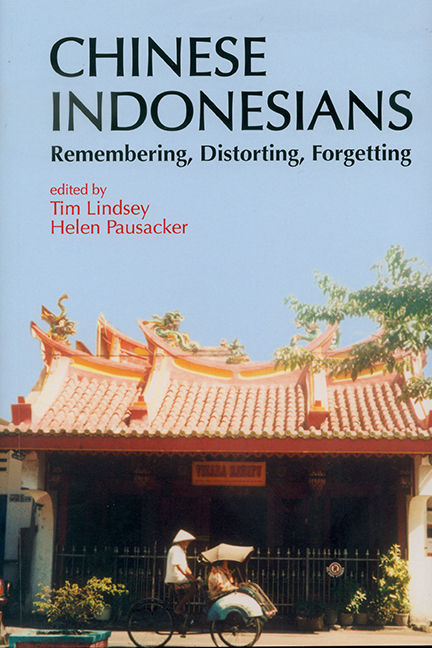Book contents
- Frontmatter
- Contents
- Preface
- A Brief Biography
- Contributors
- Glossary
- Introduction: Researching the Margins
- Bibliography of Charles Coppel's Work
- 1 Anti-Chinese Violence and Transitions in Indonesia: June 1998–October 1999
- 2 Reconstituting the Ethnic Chinese in Post-Soeharto Indonesia: Law, Racial Discrimination, and Reform
- 3 Buddhism and Confucianism in Contemporary Indonesia: Recent Developments
- 4 Portrait of the Chinese in Post-Soeharto Indonesia
- 5 The Makam Juang Mandor Monument: Remembering and Distorting the History of the Chinese of West Kalimantan
- 6 Confucianists and Revolutionaries in Surabaya (c1880–c1906)
- 7 The Chinese and the Early Centuries of Conversion to Islam in Indonesia
- 8 The Agony of Love: A Study of Peranakan Chinese Courtship and Marriage
- 9 Peranakan Chinese and Wayang in Java
- Index
8 - The Agony of Love: A Study of Peranakan Chinese Courtship and Marriage
Published online by Cambridge University Press: 21 October 2015
- Frontmatter
- Contents
- Preface
- A Brief Biography
- Contributors
- Glossary
- Introduction: Researching the Margins
- Bibliography of Charles Coppel's Work
- 1 Anti-Chinese Violence and Transitions in Indonesia: June 1998–October 1999
- 2 Reconstituting the Ethnic Chinese in Post-Soeharto Indonesia: Law, Racial Discrimination, and Reform
- 3 Buddhism and Confucianism in Contemporary Indonesia: Recent Developments
- 4 Portrait of the Chinese in Post-Soeharto Indonesia
- 5 The Makam Juang Mandor Monument: Remembering and Distorting the History of the Chinese of West Kalimantan
- 6 Confucianists and Revolutionaries in Surabaya (c1880–c1906)
- 7 The Chinese and the Early Centuries of Conversion to Islam in Indonesia
- 8 The Agony of Love: A Study of Peranakan Chinese Courtship and Marriage
- 9 Peranakan Chinese and Wayang in Java
- Index
Summary
INTRODUCTION
In all societies, through the ages, people have married, had children, and formed families. In most societies, this has also involved falling in love. However, these feelings and desires become subject to the rules, constraints, and obligations of those societies and are therefore expressed in a variety of patterns of courtship and marriage.
This chapter will provide a descriptive analysis of the nature of courtship and marriage in the Chinese community in Indonesia in 1939–42, and in particular the problems which arose for the young adults involved, as expressed through the “agony” columns of the Star Magazine. It is hoped that this would outline the values held by this community regarding courtship and marriage. Underlying the discussion of values in the magazine's “agony” columns is a theme of changing values, and we see a society aware of the difference between traditional and modern values and beginning to move away — albeit to a small degree — from traditional attitudes and behaviour.
Of course, caution must be taken with assuming that all letters in the Star Magazine's “agony” columns were written by real people with real problems. Even if they were, it should not be assumed that the letters accurately display the problems of the broader society. Nevertheless these letters do provide a unique window into the attitudes of some peranakan Chinese of this period, even if the “dialogue” between those writing the letters (the younger generation) and the agony aunt (the older generation) is seen as a type of “constructed reality”.
The Star Magazine was a peranakan monthly magazine which first appeared in January 1939 and continued publication until the 1960s.
- Type
- Chapter
- Information
- Chinese IndonesiansRemembering, Distorting, Forgetting, pp. 165 - 184Publisher: ISEAS–Yusof Ishak InstitutePrint publication year: 2005

